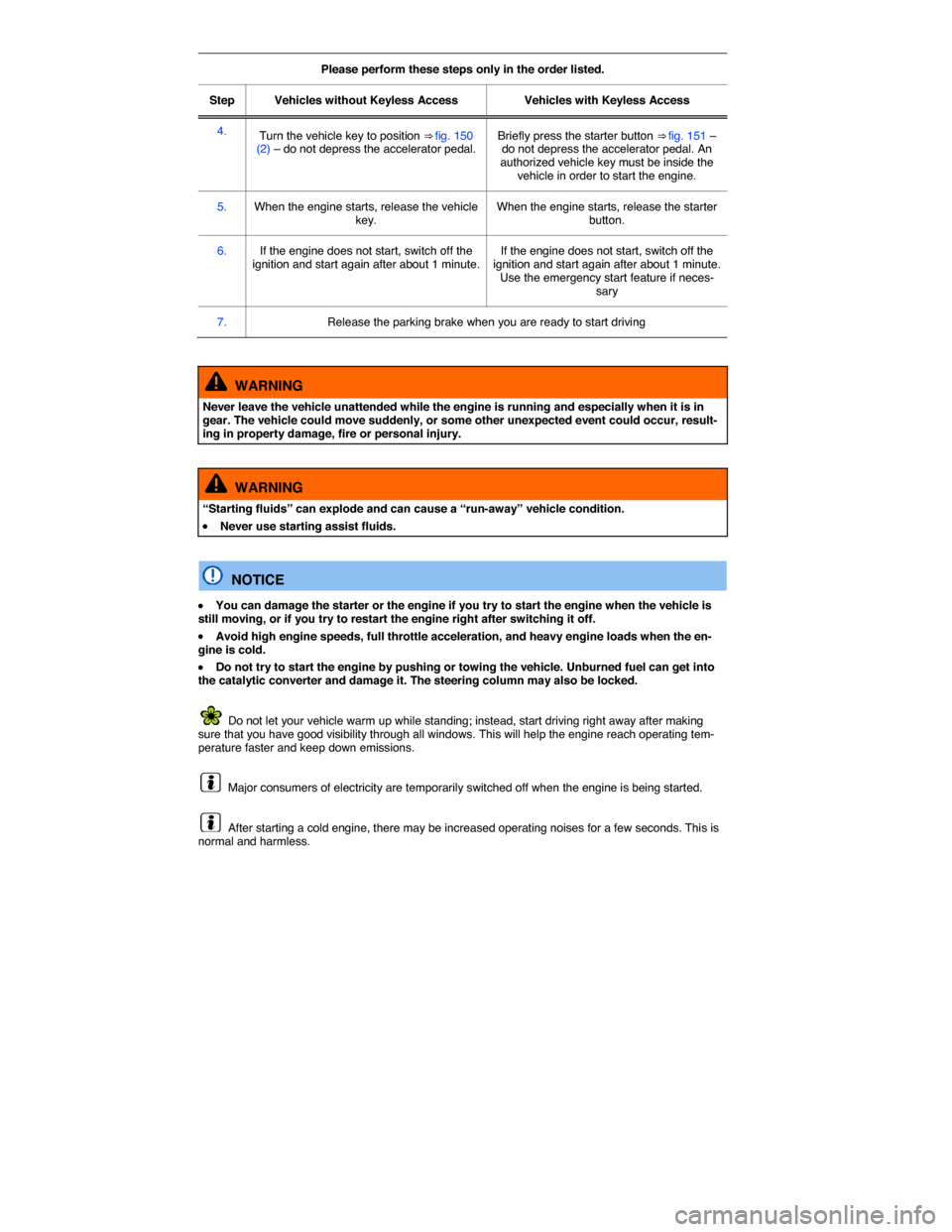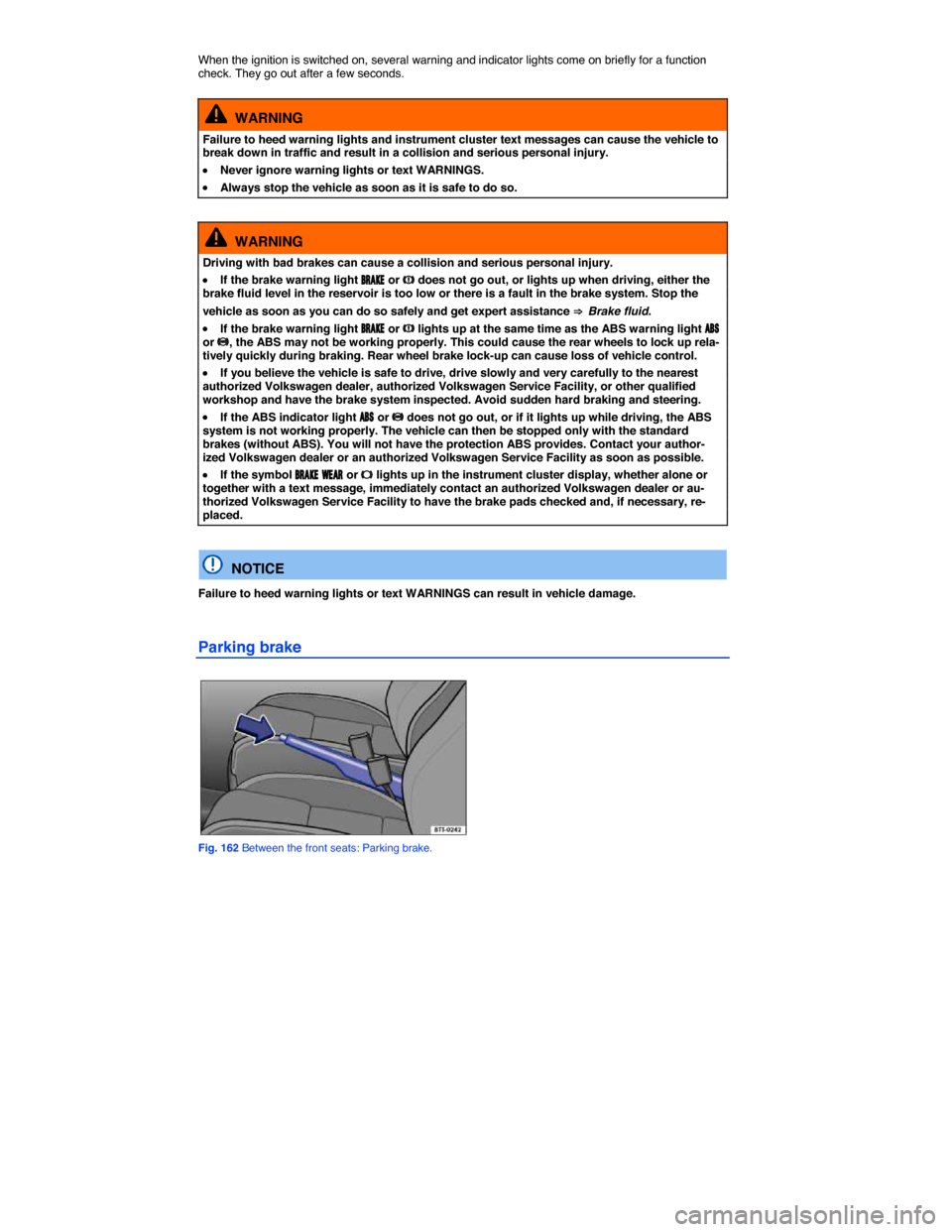Page 217 of 397

Please perform these steps only in the order listed.
Step Vehicles without Keyless Access Vehicles with Keyless Access
4. Turn the vehicle key to position ⇒ fig. 150 (2) – do not depress the accelerator pedal. Briefly press the starter button ⇒ fig. 151 – do not depress the accelerator pedal. An authorized vehicle key must be inside the vehicle in order to start the engine.
5. When the engine starts, release the vehicle key. When the engine starts, release the starter button.
6. If the engine does not start, switch off the ignition and start again after about 1 minute. If the engine does not start, switch off the ignition and start again after about 1 minute. Use the emergency start feature if neces-sary
7. Release the parking brake when you are ready to start driving
WARNING
Never leave the vehicle unattended while the engine is running and especially when it is in gear. The vehicle could move suddenly, or some other unexpected event could occur, result-ing in property damage, fire or personal injury.
WARNING
“Starting fluids” can explode and can cause a “run-away” vehicle condition.
�x Never use starting assist fluids.
NOTICE
�x You can damage the starter or the engine if you try to start the engine when the vehicle is still moving, or if you try to restart the engine right after switching it off.
�x Avoid high engine speeds, full throttle acceleration, and heavy engine loads when the en-gine is cold.
�x Do not try to start the engine by pushing or towing the vehicle. Unburned fuel can get into the catalytic converter and damage it. The steering column may also be locked.
Do not let your vehicle warm up while standing; instead, start driving right away after making sure that you have good visibility through all windows. This will help the engine reach operating tem-perature faster and keep down emissions.
Major consumers of electricity are temporarily switched off when the engine is being started.
After starting a cold engine, there may be increased operating noises for a few seconds. This is normal and harmless.
Page 241 of 397

When the ignition is switched on, several warning and indicator lights come on briefly for a function check. They go out after a few seconds.
WARNING
Failure to heed warning lights and instrument cluster text messages can cause the vehicle to break down in traffic and result in a collision and serious personal injury.
�x Never ignore warning lights or text WARNINGS.
�x Always stop the vehicle as soon as it is safe to do so.
WARNING
Driving with bad brakes can cause a collision and serious personal injury.
�x If the brake warning light �"�2�!�+�% or �H does not go out, or lights up when driving, either the brake fluid level in the reservoir is too low or there is a fault in the brake system. Stop the
vehicle as soon as you can do so safely and get expert assistance ⇒ Brake fluid.
�x If the brake warning light �"�2�!�+�% or �H lights up at the same time as the ABS warning light �!�"�3 or �J, the ABS may not be working properly. This could cause the rear wheels to lock up rela-tively quickly during braking. Rear wheel brake lock-up can cause loss of vehicle control.
�x If you believe the vehicle is safe to drive, drive slowly and very carefully to the nearest authorized Volkswagen dealer, authorized Volkswagen Service Facility, or other qualified workshop and have the brake system inspected. Avoid sudden hard braking and steering.
�x If the ABS indicator light �!�"�3 or �J does not go out, or if it lights up while driving, the ABS system is not working properly. The vehicle can then be stopped only with the standard brakes (without ABS). You will not have the protection ABS provides. Contact your author-ized Volkswagen dealer or an authorized Volkswagen Service Facility as soon as possible.
�x If the symbol �"�2�!�+�% �7�%�!�2 or �I lights up in the instrument cluster display, whether alone or together with a text message, immediately contact an authorized Volkswagen dealer or au-thorized Volkswagen Service Facility to have the brake pads checked and, if necessary, re-placed.
NOTICE
Failure to heed warning lights or text WARNINGS can result in vehicle damage.
Parking brake
Fig. 162 Between the front seats: Parking brake.
Page 394 of 397

Towing manual transmission vehicles
�x Release the parking brake.
�x Shift the transmission into Neutral (N).
�x If possible, have the vehicle towed with the front wheels off the ground.
�x If necessary, the vehicle can also be towed with the rear wheels off the ground ⇒ .
Towing automatic transmission vehicles
�x Release the parking brake.
�x Shift the transmission into Neutral (N).
�x Tow the vehicle only with its front wheels off the ground ⇒ .
When not to tow your vehicle
If there is little or no oil in the transmission because of damage to your vehicle, it must be moved with the drive wheels off the ground. The vehicle can only be towed if its ignition is switched on and its electrical system is operating. In the following situations, the vehicle cannot be towed at all and must be transported on a flatbed truck or trailer:
�x If the front and rear wheels cannot turn.
�x If the vehicle battery is dead (because the electronic steering column lock engages and cannot be released).
�x If you have to tow an automatic transmission vehicle more than 30 miles (50 km).
WARNING
It is not safe for children or other persons to ride in a vehicle that is being towed.
�x Never let children or anyone else remain in the vehicle while it is being towed.
NOTICE
The drive axle rotates while the vehicle is being towed with its rear wheels off the ground. This can damage the automatic transmission.
�x Never tow automatic transmission vehicle with the rear wheels off the ground.
�x Tow manual transmission vehicles with the rear wheels off the ground only if it is certain that no transmission fluid can leak out.